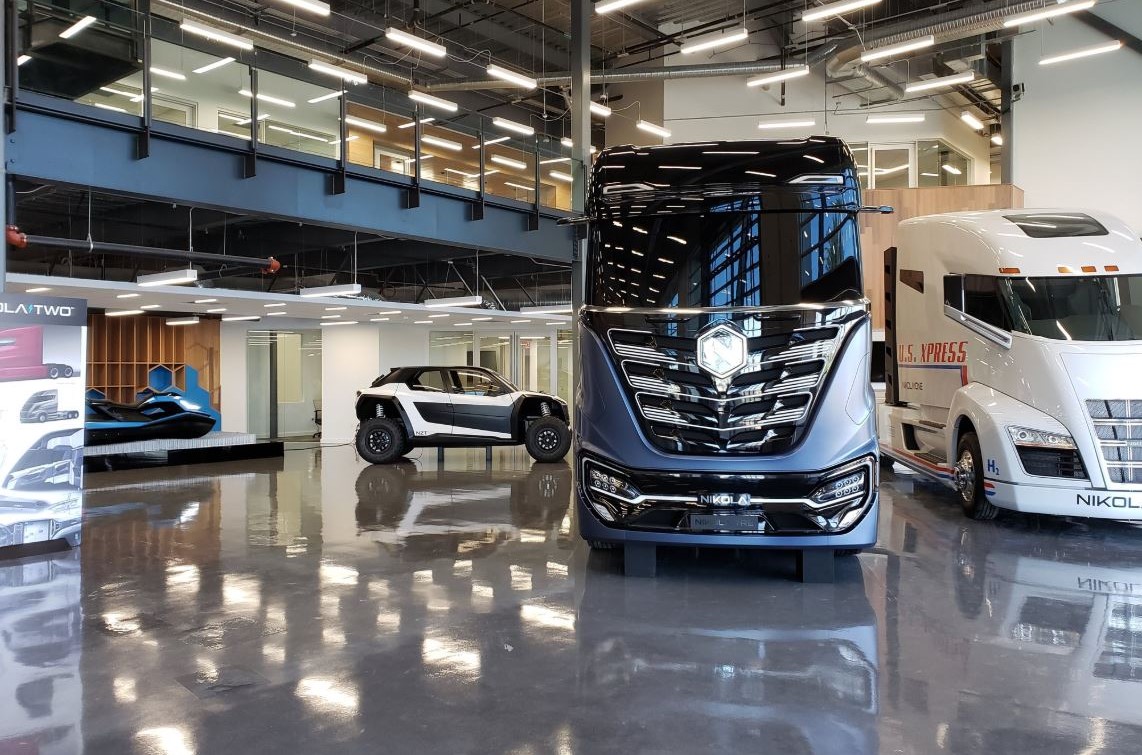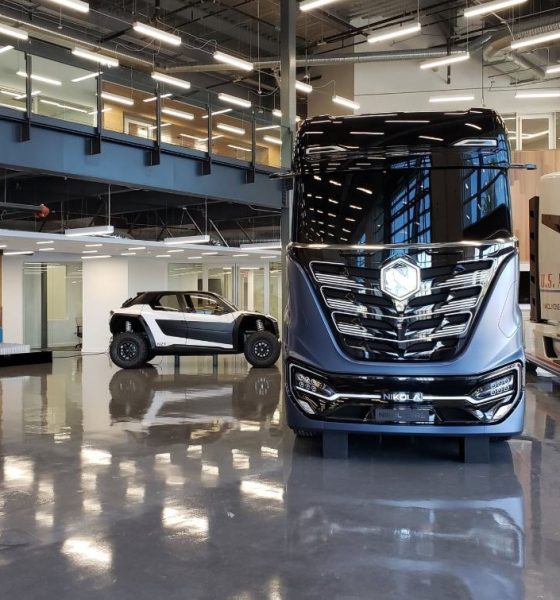

News
Nikola Motors loses founder Trevor Milton amid SEC and DOJ probe
It appears that Nikola is facing a very steep hill ahead, with reports indicating that founder Trevor Milton has departed from the company, effective immediately. The update was reported by esteemed semi-truck-focused publication Freightwaves, which cited sources close to the embattled hydrogen fuel cell truck maker.
Amidst his departure from Nikola, Trevor Milton will also be resigning as Executive Chairman. He will remain as one of the company’s largest shareholders, though he would reportedly not have any say about how Nikola will be managed moving forward. The publication’s sources noted that the decision to resign and leave was Milton’s, and it was done to protect Nikola and his investment.
“Nikola is truly in my blood and always will be, and the focus should be on the Company and its world-changing mission, not me. So I made the difficult decision to approach the Board and volunteer to step aside as Executive Chairman. Founding Nikola and growing it into a company that will change transportation for the better and help protect our world’s climate has been an incredible honor,” Milton noted in a press release.
To date, it is estimated that Milton owns about 82 million shares of Nikola. That translates to about 20% of the hydrogen fuel cell truck maker, or about $2.8 billion.
With Milton stepping down, Stephen Girsky, former Vice Chairman of General Motors Co. and a member of Nikola’s Board, has been appointed Chairman of the Board, effective immediately. Milton noted in the company’s press release that he is confident Girsky is the right person to lead Nikola as the company moves forward. He also remained optimistic about Nikola’s leadership, which he believes could allow the company to reach its full potential.
“As we move forward, I am confident Steve is the right leader to guide our vision at the Board level. In addition to being an early believer and supporter of Nikola, Steve has more than 30 years of experience working with OEM leaders, suppliers, dealers, labor leaders and national policy makers, and has served as a director of numerous public companies.”
“We’ve built a deep bench of talent over the years, and I am confident that Nikola’s Chief Executive Officer, Mark Russell, supported by Chief Financial Officer, Kim Brady, and the rest of the leadership team will advance our goal of making Nikola the global leader in zero-emissions transportation. I want to thank all of Nikola’s employees, investors and partners who have shared in my vision and rallied behind Nikola during this time,” Milton noted.
Girsky, for his part, has expressed his excitement for his new appointment. “I want to thank Trevor for his visionary leadership and significant contributions to Nikola since its founding. Trevor saw the possibility of creating an end-to-end zero-emission transportation system when the industry was still in its nascent stages and took action to build the Nikola of today, with world-class partnerships, groundbreaking R&D, and a revolutionary business model. I know I speak for everyone at Nikola in our gratitude and in wishing him all the best,” he said.
Milton’s departure marks yet another remarkable development in the Nikola saga, which has gone on a full roller coaster ride in recent weeks. Following a blockbuster announcement of a manufacturing deal with GM for its Badger pickup, Nikola was shaken by a report from short-seller firm Hindenburg Research, which alleged that Milton and the company had a history of misleading investors and the public.
Among the key allegations from Hindenburg stated that Nikola has misrepresented the progress it has made with its technologies and vehicle projects. Nikola and Milton later posted a response to the firm’s accusations, though the release only addressed a fraction of Hindenburg’s allegations. Together with its response, Nikola also contacted the SEC, stating that it welcomes the regulator’s involvement. A later report from The Wall Street Journal indicated that the SEC review into the company was in its early stages, and that the US Justice Department has joined the investigation into Nikola.
Nikola has garnered a reputation for being polarizing. While the company is lauded by its supporters for its grand vision of a zero-emissions future dominated by hydrogen-powered long-haulers, critics have argued that Milton’s claims about Nikola’s vehicles were not realistic. The former Nikola executive’s active presence on Twitter further added to the company’s skirmishes with its outspoken critics.
While Milton’s departure will likely be a blow to Nikola, the company appears to have legitimate projects currently underway. Amidst the controversy surrounding the Hindenburg report, for example, GM Chief Executive Mary Barra stated that the veteran American automaker remains committed to the Nikola deal. With this in mind, the release of the Badger may still happen, though it would be interesting to see how Nikola moves on without its founder. “Our company has worked with a lot of different partners. We’re a very capable team that has done the appropriate diligence,” she said.
Read Nikola’s full press release about Trevor Milton’s departure here.

Elon Musk
Elon Musk and Tesla AI Director share insights after empty driver seat Robotaxi rides
The executives’ unoccupied tests hint at the rapid progress of Tesla’s unsupervised Robotaxi efforts.

Tesla CEO Elon Musk and AI Director Ashok Elluswamy celebrated Christmas Eve by sharing personal experiences with Robotaxi vehicles that had no safety monitor or occupant in the driver’s seat. Musk described the system’s “perfect driving” around Austin, while Elluswamy posted video from the back seat, calling it “an amazing experience.”
The executives’ unoccupied tests hint at the rapid progress of Tesla’s unsupervised Robotaxi efforts.
Elon and Ashok’s firsthand Robotaxi insights
Prior to Musk and the Tesla AI Director’s posts, sightings of unmanned Teslas navigating public roads were widely shared on social media. One such vehicle was spotted in Austin, Texas, which Elon Musk acknowleged by stating that “Testing is underway with no occupants in the car.”
Based on his Christmas Eve post, Musk seemed to have tested an unmanned Tesla himself. “A Tesla with no safety monitor in the car and me sitting in the passenger seat took me all around Austin on Sunday with perfect driving,” Musk wrote in his post.
Elluswamy responded with a 2-minute video showing himself in the rear of an unmanned Tesla. The video featured the vehicle’s empty front seats, as well as its smooth handling through real-world traffic. He captioned his video with the words, “It’s an amazing experience!”
Towards Unsupervised operations
During an xAI Hackathon earlier this month, Elon Musk mentioned that Tesla owed be removing Safety Monitors from its Robotaxis in Austin in just three weeks. “Unsupervised is pretty much solved at this point. So there will be Tesla Robotaxis operating in Austin with no one in them. Not even anyone in the passenger seat in about three weeks,” he said. Musk echoed similar estimates at the 2025 Annual Shareholder Meeting and the Q3 2025 earnings call.
Considering the insights that were posted Musk and Elluswamy, it does appear that Tesla is working hard towards operating its Robotaxis with no safety monitors. This is quite impressive considering that the service was launched just earlier this year.
Elon Musk
Starlink passes 9 million active customers just weeks after hitting 8 million
The milestone highlights the accelerating growth of Starlink, which has now been adding over 20,000 new users per day.

SpaceX’s Starlink satellite internet service has continued its rapid global expansion, surpassing 9 million active customers just weeks after crossing the 8 million mark.
The milestone highlights the accelerating growth of Starlink, which has now been adding over 20,000 new users per day.
9 million customers
In a post on X, SpaceX stated that Starlink now serves over 9 million active users across 155 countries, territories, and markets. The company reached 8 million customers in early November, meaning it added roughly 1 million subscribers in under seven weeks, or about 21,275 new users on average per day.
“Starlink is connecting more than 9M active customers with high-speed internet across 155 countries, territories, and many other markets,” Starlink wrote in a post on its official X account. SpaceX President Gwynne Shotwell also celebrated the milestone on X. “A huge thank you to all of our customers and congrats to the Starlink team for such an incredible product,” she wrote.
That growth rate reflects both rising demand for broadband in underserved regions and Starlink’s expanding satellite constellation, which now includes more than 9,000 low-Earth-orbit satellites designed to deliver high-speed, low-latency internet worldwide.
Starlink’s momentum
Starlink’s momentum has been building up. SpaceX reported 4.6 million Starlink customers in December 2024, followed by 7 million by August 2025, and 8 million customers in November. Independent data also suggests Starlink usage is rising sharply, with Cloudflare reporting that global web traffic from Starlink users more than doubled in 2025, as noted in an Insider report.
Starlink’s momentum is increasingly tied to SpaceX’s broader financial outlook. Elon Musk has said the satellite network is “by far” the company’s largest revenue driver, and reports suggest SpaceX may be positioning itself for an initial public offering as soon as next year, with valuations estimated as high as $1.5 trillion. Musk has also suggested in the past that Starlink could have its own IPO in the future.
News
NVIDIA Director of Robotics: Tesla FSD v14 is the first AI to pass the “Physical Turing Test”
After testing FSD v14, Fan stated that his experience with FSD felt magical at first, but it soon started to feel like a routine.

NVIDIA Director of Robotics Jim Fan has praised Tesla’s Full Self-Driving (Supervised) v14 as the first AI to pass what he described as a “Physical Turing Test.”
After testing FSD v14, Fan stated that his experience with FSD felt magical at first, but it soon started to feel like a routine. And just like smartphones today, removing it now would “actively hurt.”
Jim Fan’s hands-on FSD v14 impressions
Fan, a leading researcher in embodied AI who is currently solving Physical AI at NVIDIA and spearheading the company’s Project GR00T initiative, noted that he actually was late to the Tesla game. He was, however, one of the first to try out FSD v14.
“I was very late to own a Tesla but among the earliest to try out FSD v14. It’s perhaps the first time I experience an AI that passes the Physical Turing Test: after a long day at work, you press a button, lay back, and couldn’t tell if a neural net or a human drove you home,” Fan wrote in a post on X.
Fan added: “Despite knowing exactly how robot learning works, I still find it magical watching the steering wheel turn by itself. First it feels surreal, next it becomes routine. Then, like the smartphone, taking it away actively hurts. This is how humanity gets rewired and glued to god-like technologies.”
The Physical Turing Test
The original Turing Test was conceived by Alan Turing in 1950, and it was aimed at determining if a machine could exhibit behavior that is equivalent to or indistinguishable from a human. By focusing on text-based conversations, the original Turing Test set a high bar for natural language processing and machine learning.
This test has been passed by today’s large language models. However, the capability to converse in a humanlike manner is a completely different challenge from performing real-world problem-solving or physical interactions. Thus, Fan introduced the Physical Turing Test, which challenges AI systems to demonstrate intelligence through physical actions.
Based on Fan’s comments, Tesla has demonstrated these intelligent physical actions with FSD v14. Elon Musk agreed with the NVIDIA executive, stating in a post on X that with FSD v14, “you can sense the sentience maturing.” Musk also praised Tesla AI, calling it the best “real-world AI” today.








